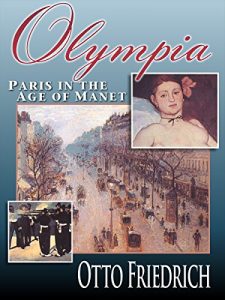Otto Friedrich’s account of Paris (“the capital of the 19th century”) during the Second Empire brilliantly evokes an era and vividly depicts its people and events. The central character is Manet with an awe-inspiring supporting cast of Napoleon III, Empress Eugénie, Wagner, Flaubert, Bismarck, Offenbach, Proust, Degas, Haussmann, Zola, Monet, and Victor Hugo. Though Manet never paints Empress Eugénie, the most powerful woman in France, he does paint the execution of Maximilian in Mexico (which is only one of the ill-fated schemes urged on Napoleon III by the Empress) and he does paint Berthe Morisot—eleven times, in fact, with whom he is clearly in love—but she marries his brother.
Baron Haussmann tears up and rebuilds most of central Paris. Manet paints a portrait of Nana as a mindless showgirl. Zola, at almost the same time, writes Nana as a portrait of a woman as a devourer. Bismarck provokes and Empress Eugénie prods Napoleon into war. Napoleon loses his entire army and surrenders at Sedan. The Third Republic is proclaimed in Paris. Manet and Degas serve in the defending army. Victor Hugo publishes a cookbook on how to cook rats. Under siege, Paris surrenders. The French government attacks and massacres the Communards. The Impressionists paint and quarrel among themselves.
“Rich, vivid, imaginatively organized,” continued Kirkus, “a 19th-century Bonfire of the Vanities, a true one, ready for the big screen… Memorable vignettes include the exiled Wagner producing Tannhäuser for the frivolous Parisians; the massacre of citizens in Napoleon's coup and again after his defeat; the Exposition of 1867, with its 52,000 exhibits; and a history of syphilis, the disease that probably took Manet's life.” “Friedrich’s technique,’ wrote Malcolm L. Johnson in the Hartford Courant, “born of Time compression, is to read everything available and then distill it into readable, anecdotal, humorous history.”
This eBook edition includes interactive links between text and artwork.






